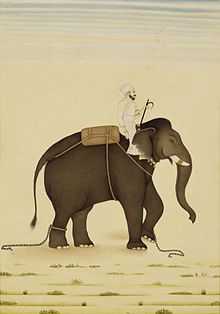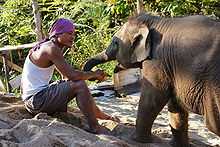Mahout
- For the machine learning project, see Apache Mahout.


%2C_f.117v_-_BL_Add._27255.jpg)
A mahout is a person who rides an elephant. The word mahout comes from the Hindi words mahaut (महौत) and mahavat (महावत), which eventually goes back to Sanskrit mahamatra (महामात्र). Usually, a mahout starts as a boy in the 'family profession' when he is assigned an elephant early in its life. They remain bonded to each other throughout their lives.[1]
The most common tools used by mahouts are chains and the Goad Aṅkuśa (or ankus, anlius) –a sharp metal hook used in the training and handling of the elephant by stabbing the elephant in the head, and in areas like the mouth and inner ear, where the animal is most sensitive.[2]
Devices used to control elephants in India

In India, especially Kerala, mahouts use three types of device to control elephants. The thotti (hook), which is 3.5 feet in length and 3 inches thick; the valiya kol (long pole), which is 10.5 feet in length and 5.5 inches in thickness; and the cheru kol (short pole).[3] (See also Elephants in Kerala culture.)
Terminology
Another term for mahout is cornac (as in French, from the Portuguese; kornak in Polish, also a rather current last name). This word comes form Sanskrit term karināyaka, the compound of Sanskrit words karin (elephant) and nayaka (leader). In Tamil, the word used is "pahan", which means elephant keeper, and in Sinhalese kurawanayaka ('stable master'). In Malayalam the word used is paappaan.

In Burma, the profession is called oozie; in Thailand kwan-chang; and in Vietnam quản tượng.
Miscellaneous
Elephants have been integral to politics and the economy in Africa and Asia. Many elephants are given away on requests of government ministers and sometimes as gifts. Elephants traditionally work for the forest service and logging business.

In India there has been controversy over elephants attacking mahouts and villagers due to the torture some elephants endure from their mahouts, especially during festivals. More than 90% of the elephants in Kerala, for example, are not obtained legally.
The Singapore Zoo features a show called "elephants at work and play", where the elephants' caretakers are referred to as "mahouts", and demonstrate how elephants are used as beasts of burden in south-east Asia. The verbal commands given to the elephants by the mahouts are all in Sinhalese, one of the two official languages of Sri Lanka.
- In popular culture
A shop display advertising "Mahout" cigarettes features prominently in the background of the "rain dance" sequence of the famous 1952 Gene Kelly film Singin' in the Rain. The word "mahout" also features in the lyrics of the song "Drop the Pilot", by Joan Armatrading.
Literature
George Orwell's essay "Shooting an Elephant" discusses the relationship of an elephant to its mahout: "It was not, of course, a wild elephant, but a tame one which had gone 'must.' It had been chained up, as tame elephants always are when their attack of 'must' is due, but on the previous night it had broken its chain and escaped. Its mahout, the only person who could manage it when it was in that state, had set out in pursuit, but had taken the wrong direction and was now twelve hours' journey away..."
See also
- Elephants in Kerala culture
- War elephant, for soldiers in the mahout role, often armed and combatant
- Howdah, a carriage mounted on the back of an elephant
- Elefantasia, for information on mahouts living and working in Laos
References
- ↑ Weeratunge, Chamalee, The Elephant Gates. Greenleaf Book Group, 2014, p. 104. (Google eBook)
- ↑ Fowler, Mikota, eds. Biology, Medicine and Surgery of Elephants. John Wiley & Sons, 2008, p. 54.
- ↑ Ajitkumar, Anil, Alex, eds., Healthcare Management of Captive Asian Elephants Kerala Agricultural University, 2009, p. 165
- National Geographic
- The Hindu
- Frontline
- Elephant glossary
 This article incorporates text from a publication now in the public domain: Chisholm, Hugh, ed. (1911). Encyclopædia Britannica (11th ed.). Cambridge University Press.
This article incorporates text from a publication now in the public domain: Chisholm, Hugh, ed. (1911). Encyclopædia Britannica (11th ed.). Cambridge University Press.
